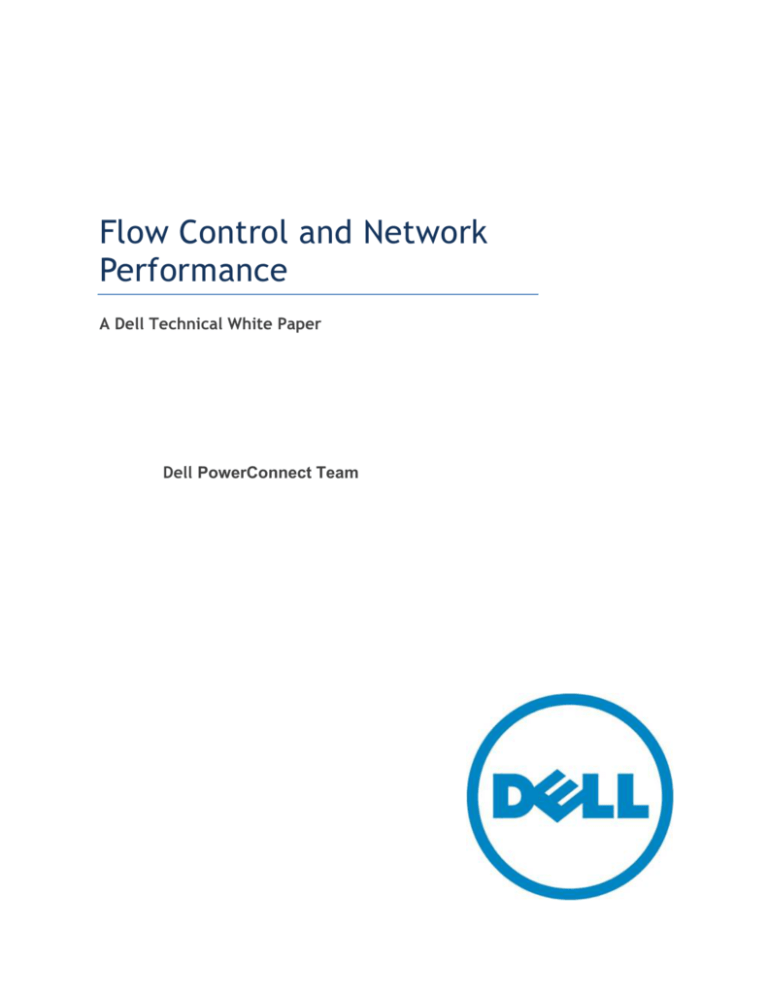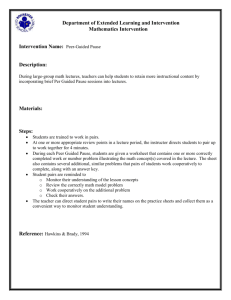
Flow Control and Network
Performance
A Dell Technical White Paper
Dell PowerConnect Team
Flow Control and Network Performance
THIS WHITE PAPER IS FOR INFORMATIONAL PURPOSES ONLY, AND MAY CONTAIN TYPOGRAPHICAL
ERRORS AND TECHNICAL INACCURACIES. THE CONTENT IS PROVIDED AS IS, WITHOUT EXPRESS OR
IMPLIED WARRANTIES OF ANY KIND.
© 2011 Dell Inc. All rights reserved. Reproduction of this material in any manner whatsoever without
the express written permission of Dell Inc. is strictly forbidden. For more information, contact Dell.
Dell, the DELL logo, and the DELL badge, PowerConnect, and PowerVault are trademarks of Dell Inc.
Symantec and the SYMANTEC logo are trademarks or registered trademarks of Symantec Corporation or
its affiliates in the US and other countries. Microsoft, Windows, Windows Server, and Active Directory
are either trademarks or registered trademarks of Microsoft Corporation in the United States and/or
other countries. Other trademarks and trade names may be used in this document to refer to either the
entities claiming the marks and names or their products. Dell Inc. disclaims any proprietary interest in
trademarks and trade names other than its own.
April 2011
Page ii
Flow Control and Network Performance
Contents
A Dell Technical White Paper ........................................................................................ Dell PowerConnect Team ............................................................................................. Introduction .............................................................................................................. 2 External Head of Line Blocking .................................................................................. 2 Congestion Spreading ............................................................................................. 3 Annex 31B Flow Control Operation ................................................................................... 4 Annex 31B Flow Control and TCP ..................................................................................... 4 Industry Flow Control Implementations ............................................................................. 4 Flow Control Alternatives .............................................................................................. 5 Alternative 1 .......................................................................................................... 5 Alternative 2 .......................................................................................................... 5 PowerConnect Flow Control Implementation....................................................................... 5 PowerConnect Stacking ................................................................................................ 6 Summary .................................................................................................................. 6 References ............................................................................................................... 7 Page 1
Flow Control and Network Performance
Introduction
Flow control is defined in Annex 31B “MAC Control PAUSE operation” of the IEEE 802.3 Standard [1].
Transmission of Annex 31B PAUSE frames may be useful when deployed at the edge of a network for
certain specific situations, but is generally considered harmful in the network core due to the effects
of external head of line blocking and congestion spreading [3]. Due to these effects, Annex 31B flow
control is not considered as a viable method for implementing lossless Ethernet in general network
deployments. There are other flow control alternatives that implement lossless Ethernet in very limited
deployments [10]. In this paper, we discuss head of line blocking and congestion spreading, Annex 31B
flow control operation and its interactions with TCP, and then discuss the Dell PowerConnect
implementation of flow control along with some possible deployment alternatives in implementing flow
control.
External Head of Line Blocking
Consider the network diagram below. In this example, host A is transmitting at 100% line rate to host D
and host B is periodically transmitting bursts of traffic to host D at 10% of line rate. Hosts B & C are
transmitting at 90% of line rate to each other. This results in a periodic 10% oversubscription of the link
from the switch to D.
A
B
A->D:100%
D
B->D: 10%
B->C:90%
C->B:90%
C
Due to the oversubscription of the link between the switch and host D, the switch will send pause
frames to all ports attempting to send packets to host D. In this example the switch will send pause
frames to both host A and host B which has the undesirable effect of blocking the packets host B is
transmitting to host C. This is known as external head of line blocking.
It is readily understandable that head of line blocking is undesirable as it not fair (traffic from B to C is
blocked) and it is wasteful of network resources (overall A and B link utilization is reduced).
Page 2
Flow Control and Network Performance
Congestion Spreading
Consider the network diagram below. In this example, host A is transmitting at 100% line rate to host D
via switch Y. Hosts E and F are transmitting at 45% of line rate to host C via switches X and Y. Hosts E
and F are also each periodically transmitting bursts of traffic at 5% of line rate to host D via switches X
and Y. This situation results in a periodic 10% oversubscription of the link from switch Y to host D.
A
F
F->D: 5%
F->C:45%
X
E
A->D:100%
Y
D
E->D: 5%
E->C:45%
C
Due to the oversubscription of the link between the switch and host D, switch Y will send pause frames
to all ports attempting to send packets to host D. In this example switch Y will send pause frames to
both host A and switch X. This in turn may cause PAUSE frames to be sent to hosts E and F as switch X
becomes congested due to the lowered throughput on the link from switch X to switch Y. This has the
undesirable effect of blocking packets sent from hosts E and F to host C. This is known as congestion
spreading [8].
Page 3
Flow Control and Network Performance
Annex 31B Flow Control Operation
Annex 31B flow control operates by sending a link local frame addressed to the peer or to a well-known
MAC address specifically used for flow control. In the frame is a timer quanta (in increments of 512 bit
times) for which the transmitter is required to cease transmission. The station sending the pause frame
may also send a frame with a 0 pause quanta value, indicating that the paused peer may resume
transmission.
In reality, IEEE 802.3 Annex 31B flow control is a method of congestion control [4]. It is generally well
understood that IEEE 802.3 Annex 31B flow control does not and cannot solve steady-state oversubscription [3]. The effect of flow control is to temporarily increase the network device buffer by
utilizing the buffer of the neighbor for a brief period of time. A consequence is that the maximum link
capability is reduced, which exacerbates the very condition that Annex 31B flow control was intended
to solve. In some cases, the maximum link capacity may be reduced to a fraction of its original
capacity. Network equipment manufacturers generally recommend that flow control only be used on
access ports connected to end hosts [2,3,4]. This is because of the issues surrounding congestion
spreading and the fact that nearly all switches today can forward at line rate speeds.
Annex 31B Flow Control and TCP
Higher layer protocols like TCP rely on packet loss as an indication to transmit more slowly (halves the
transmission rate) [7]. When implemented throughout a network, Annex 31B flow control makes the
TCP retransmission algorithm redundant, but at the cost of lower network throughput. In addition, flow
control interferes with the TCP RTT measurement. Because of congestion spreading and head of line
blocking effects, most network administrators prefer to use TCP retransmission over Annex 31B flow
control as it allows utilization of the full network bandwidth.
Industry Flow Control Implementations
Device
Cisco 3750
Cisco 6500
Cisco 2970
J and SRX Series
HP ProCurve
HP ProCurve
Configurability
Interface
Interface
Interface
Interface
9300
2400m/4000m
Tx Pause
No
Yes (default off)
No
Yes
Yes (global threshold)
No
Rx Pause
Yes
Yes
Yes
Yes
Yes
No
It should be readily apparent from the above table that different vendors implement flow control in
very different – and not necessarily compatible ways. What may be more interesting is that many
network peripheral vendors, while recommending use of flow control, are not clear about the desired
behavior of flow control in the network or with their devices, and thus may mislead network operators
into deployments of flow control which lead to lower network performance or high packet loss ratios or
both [5,9].
Page 4
Flow Control and Network Performance
Flow Control Alternatives
In this section, we discuss possible alternatives to global deployment of symmetric flow control or no
flow control which may be considered by network operators. What is most important is to understand is
that flow control, if it is to be utilized, must be implemented in a consistent manner across the
network and with an understanding of the specific implementation on each network device. Ad hoc
implementations of flow control are likely to cause significant network impairments, including high
packet loss ratios and significantly degraded network throughput.
Alternative 1
Asymmetric (rx only) flow control is deployed throughout the network. Should a device be deployed in
the network which implements symmetric flow control, the directly attached devices will operate in a
compatible manner. This alternative will allow the network to be utilized at maximum capacity,
although with a potentially higher packet loss ratio. Deployment of sufficient network capacity can
lessen packet loss effects to near zero. Monitoring network traffic flows by periodically polling the
switch from a network management system will assist in planning network capacity enhancements and
in understanding network traffic flow.
Alternative 2
Asymmetric (rx only) flow control is deployed throughout the network in conjunctions with symmetric
flow control utilized for directly attached hosts. This deployment pattern assists in protecting the
network from any host or group of hosts from affecting network operation by sending long or large
bursts of traffic. This alternative will allow the network to be utilized at close to maximum capacity
since interior links operate at full capacity and only exterior links are flow controlled. With sufficient
network capacity deployed, packet loss can be limited to a very small fraction of total traffic.
Monitoring network traffic flows by periodically polling the switch from a network management system
will assist in planning network capacity enhancements and in understanding network traffic flow.
PowerConnect Flow Control Implementation
In the PICS Proforma section 31B.4.3 or IEEE 802.3, support for transmission of PAUSE frames is
optional. When flow control is enabled, PowerConnect devices transmit PAUSE frames when congested,
however, there are differences between the 62xx PowerConnect and later PowerConnect devices. PC
62xx switches are based on StratXGS-III silicon, which has limited buffer space and therefore becomes
congested sooner when confronted with bursty traffic. Later PowerConnect devices such as the
PC70xx/PC80xx series switches are based on StrataXGS-IV silicon with significantly more internal buffer
space available to handle transient bursts. All PowerConnect devices use a shared-memory nonblocking architecture.
An StrataXGS-IV PowerConnect switch configured with flow control enabled uses ingress back pressure
to support lossless egress buffering. Ingress back pressure enables per switch management of an
oversubscribed port through the use of PAUSE flow control at the source port. The destination module
keeps counts for all incoming packets according to their source port. When those counters exceed the
configured limit, a message is sent with flow control information to the offending source port(s). In this
mode, the ingress limits are lowered and the egress limits are raised.
Page 5
Flow Control and Network Performance
A StrataXGS-IV based PowerConnect switch configured with flow control disabled does not use the back
pressure mechanism to control congestion. Instead, the egress limits are lowered and ingress limits are
disabled. In this case, the switch will discard frames earlier than with flow control enabled.
StrataXGS-IV devices implement more aggressive memory allocation schemes intended to better
tolerate bursty network behavior than StrataXGS-III devices. These allocation schemes include dynamic
allocation of buffers and adjustment of limits based on real-time usage information.
PowerConnect Stacking
PowerConnect stacking operates over the stacking ports using a proprietary protocol to transport
Ethernet frames with low latency. In general, stacking ports have higher bandwidth limits in order to
reduce congestion issues and mitigate the need for flow control on the stacking links. However,
PowerConnect stacking does not implement flow control over stacking links and does not have a
feedback mechanism to control packet ingress from the egress ports located on other stack members.
The stacking port itself is an egress port with fixed limits. This leads to a situation where multiple
ingress links may forward traffic to a stacking link in excess of the egress limits. This will lead to
internal packet discards as the output queue exceeds the configured thresholds. On the other hand,
the disabling of ingress limits when flow control is disabled, coupled with the more aggressive memory
management of StrataXGS-IV devices can often lead to higher throughput with minimal loss in stacking
environments if an appropriate design to limit oversubscription is in place.
Summary
Many factors come into play in considering whether to use flow control in a network. We have listed
many of the factors to consider as well as recommendations from multiple switch vendors. We have
also listed the differences between industry implementations of flow control. PowerConnect switches
conform to all relevant IEEE standards with regards to Annex 31B flow control. Broadcom’s
recommendation mirrors that of the other large networking equipment vendors [2,4]. Flow control
(transmission of PAUSE frames) should only be implemented at the network edge, when needed, and
asymmetric flow control should be implemented in the core to interoperate with other vendor
implementations and assure maximum possible network throughput. Appropriate network design must
be performed to ensure that interior network links are not over-subscribed. Operators should be aware
of the limitations of utilizing flow control in stacking solutions and take steps to mitigate issues that
may be encountered.
Page 6
Flow Control and Network Performance
References
1. IEEE 802.3 Standard for Information technology—Telecommunications and information
exchange between systems—Local and metropolitan area networks—Specific requirements
(http://standards.ieee.org/about/get/802/802.3.html)
2. Best Practices for Catalyst 4500/400, 55090/5000 and 6500/600 Series Switches Running CatOS
Configuration and Management
(http://www.cisco.com/en/US/products/hw/switches/ps663/products_tech_note09186a00800
94713.shtml)
3. Network World - Vendors on Flow Control
(http://www.networkworld.com/netresources/0913flow2.html)
4. Flow Control (http://en.wikipedia.org/wiki/Flow_control)
5. Virtual Threads – Beware Ethernet Flow Control
(http://virtualthreads.blogspot.com/2006/02/beware-ethernet-flow-control.html)
6. Informatica - Ethernet Flow Control
(http://www.informatica.com/downloads/1568_high_perf_messaging_wp/Topics-in-HighPerformance-Messaging.htm)
7. TCP/IP Illustrated – Volume 1 – The Protocols, Stevens, Chapter 21
8. Congestion Control for Switched Ethernet, McAlpine
(http://www.cercs.gatech.edu/hpidc2005/presentations/GaryMcAlpine.pdf)
9. A guide to building an iSCSI based SAN solution with Dell™ EqualLogic™ PS Series Arrays
(http://search.yahoo.com/r/_ylt=A0oGdWnw4LZN3g8AKFxXNyoA;_ylu=X3oDMTE1ZjJxZ2JvBHNl
YwNzcgRwb3MDMQRjb2xvA3NrMQR2dGlkA1NNRTAyNV8xNjM/SIG=15r0h89nm/EXP=1303852368/**http%3a//en.community.dell.com/cfsfilesystemfile.ashx/__key/CommunityServer.Discussions.Components.Files/866/8863.Dell_5F00
_EqualLogic_5F00_Configuration_5F00_Guide.pdf)
10. IEEE 802.1Qbb – Priority-based Flow Control (http://www.ieee802.org/1/pages/802.1bb.html)
Page 7









